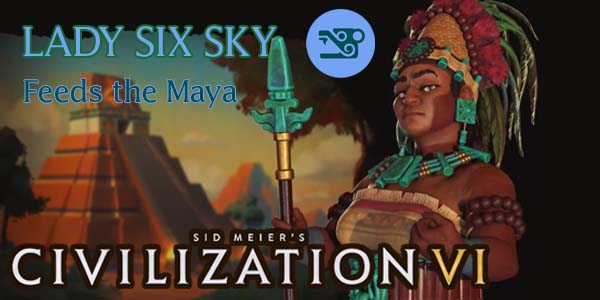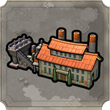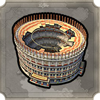
Firaxis will be releasing Civilization VI DLC packs with new game modes, new civilizations, and new leaders through March of 2021. The first such "New Frontiers" pack released in May of 2020 and included two new civilizations: the Maya and Gran Colombia.

For future releases that include multiple leaders or civilizations, I may put up polls on Patreon to let my Patrons decide which civ or leader to cover first (if Firaxis gives enough advance notice). I may also put up polls asking if my Patrons would prefer that I make guides focused on the new game modes. So if you would like to vote on which content you would prefer to see sooner, I hope you'll consider supporting the creation of this content on Patreon.
The group of peoples collectively known as the "Maya" occupied the Yucatán region of Central America. The Maya never unified under a singular state, instead consisting of a variety of theologically-governed chiefdoms and city-states, whose elites engaged in court intrigue against each other. Despite never being unified, the culture is well-known for its sophisticated writing, architecture, mathematics, astronomical observations, and its calendar system.
The Maya are perhaps most famous in popular culture for their "mysterious" disappearance, but this is mostly the result of popular misconception. It is true that large, classical Mayan cities were abandoned in the 8th and 9th centuries, but the decline is more gradual, and the civilization did not suddenly collapse overnight. Its population and power centers simply migrated north, where the Maya continued to flourish until the Spanish conquistadors conquered them. Though the exact cause(s) of the decline and migration is still a hotly disputed topic of modern archaeology. It is very likely that environmental factors played a large role, as the Maya built many of their cities in dense jungle, with thin soil and limited access to water, where they would be highly susceptible to drought and disease. In fact, the decentralized nature of the Maya allowed many remote Mayan villages to survive the Spanish conquests barely aware that anything had happened. Because of this, more than 6 million Mayan descendants still occupy the ancestral lands and speak Mayan languages.
Wak Chanil Ajaw (also known as Lady Six Sky) was the daughter of the chieftain of the city of Dos Pilas who's marriage was arranged with a prince of Naranjo in order to bring Naranjo into the Calakmul–Dos Pilas alliance. In the meantime, however, Naranjo engaged in its own conquests, and by the time Lady Six Sky took over as ruler of Naranjo (possibly as an informal regent for her son), Naranjo already had its own small empire going. As queen regent, she is believed to have acted as a warrior queen, and went on to successfully conquer several other Mayan city states. Her victories are depicted on several surviving monuments.
DISCLAIMER:
Civilization VI is still a "living game". Strategies for the game (and for specific leaders and civs) may change as Firaxis applies balance patches, introduces new features, or expands the game through further DLC or expansion packs, or as the Civ community discovers new strategies or exploits. As such, the following strategy guide may change from time to time. I will try to keep it up-to-date, and will make notations whenever changes are made. I'll also post links in the official 2K forums and CivFanatics, where I'll also report any changes made. If possible and practical, I will try to retain the original content of the strategy for posterity.
I welcome any feedback or suggestions that readers wish to offer. Feel free to post on the linked forums, or by posting a comment at the bottom of the page.
This guide is up to date as of the release of the "New Frontiers" August 2020 Update (ver. 1.0.4.8)
Lady Six Sky likes to build a tightly-packed core of highly-defensible cities improved with farms and plantations to feed her population. Cities that she builds or conquers beyond this tightly-packed core will less productive.

Lady Six Sky of the Maya's uniques in Civilization VI

Maya capital start bias: none.
Maya civilization unique: Ix Mutal Ajaw
"Non-capital cities within 6 tiles of the capital gain +10% to all yields. Other non-capital cities receive -15% to all yields. +5 combat strength to units within 6 tiles of the capital."
With an open map, the Maya can fit 12 non-capital cities within range 6 of the capital.
The Maya get a bonus for settling their cities in a tight cluster around the capital. The range of six tiles from the capital ensures you will be able to build at least a single ring of cities around the capital that will all have improved yields. If you build your cities in two rings around the capital, you can fit at most 12 non-capital cities within range 6 of the capital (as shown in the image above, created via the World Builder). The hexes in the space between cities will be shaped similar to a stubby dog bone (see image inset below).
Hexes between cities will be shaped like a "dog bone".
However, it is exceedingly unlikely that you would be able to build this many cities in actual practice. Oceans, lakes, mountains, and natural wonders will likely get in the way and limit the placement of cities. It's also highly unlikely that you'd be able to utilize Lady Six Sky's other abilities (e.g. the free amenity from adjacent luxuries) if you try to place cities in this "optimal" pattern.
In any case, you'll likely have substantial overlap of tiles between your cities. This means that you'll have to think very carefully about the placement of districts and which city owns which tiles. Districts will likely be getting adjacency bonuses from districts that belong to one or more other cities. You'll also have to ensure that you leave enough room to actually work some tiles for their yield. Map pins are a great way to plan out where you want your cities and districts!
As far as I know, tourism is not affected by city yield bonuses, so placing museums and great works in cities within 6 tiles of the capital will not gain bonus tourism; nor will cities beyond range 6 of the capital have their tourism yield penalized. If anyone can demonstrate that tourism is modified by these yield bonuses and penalties, please say so in the comments or relevant forum threads.
I believe the game rules changed in a patch at some point, but I'm not sure when. Originally, the city which first annexed a tile would own that tile for the rest of the game. Even if another city "swapped" which city was working the tile, the original city would still own it. This meant that even if you swapped which city worked the tile, the original city was still the only city that could place districts or wonders on that tile. At some point this changed, so that swapping which city works the tile also changes which city owns the tile, allowing the second city to build a district or wonder on that tile. I don't recall ever seeing this change in a patch note, so if someone knows when it changed, feel free to post in the comments. Or maybe it's always been like this, and I'm just mis-remembering?
Your units will also benefit from proximity to the capital by receiving a +5 combat bonus. This will help Maya defend their core cities from invasion and from barbarian attack.
Unfortunately, the game does not draw the range of Ix Mutal Ajaw on the map (as it does with General and Admiral ranges), so you'll have to count out the six tiles every time you need to check if something is in range of the capital. Press the "G" key on the keyboard (or activate tile hex grid in Map Options above the mini-map) in order to show the hexes and make counting easier.
Cities built (or conquered) outside of this 6-tile range from the capital will have a penalty to their yields that is of greater magnitude than the bonus of your clustered cities. Do not let this penalty prevent you from founding or conquering cities outside of the 6-tile range. Even though they will be less productive, they do not apply any global penalties to your civilization. Having cities outside of range 6 will not hurt your cities that are within range 6. Even with the 15% yield penalty, a well-placed city with good district adjacency and resources can still be a productive and valuable contributor to your empire. Also note that the capital does not receive a bonus or penalty to yield.
Lady Six Sky's leader unique: Mayab
"Settling next to fresh water and coast does not provide extra Housing, instead each Farm provides an additional +1 Housing and +1 Gold. +1 Amenity for each luxury resource adjacent to the City Center."

To help Lady Six Sky get her cities packed in as tightly as possible, she does not have to worry as much about founding cities adjacent to water. Her cities do not receive the normal housing benefit of founding a city along a river, next to a lake or oasis, or adjacent to the coast. All cities receive a flat 2 housing, regardless of their position relative to water. In the city info panel, this flat 2 housing will show up as being "housing from water". Normally, a city adjacent to fresh water would get 5 housing.
Instead of housing from water, her cities will receive most of their housing from farms. Each farm normally provides 1/2 housing, but Lady Six Sky's farms each provide 1 extra, for a total of 1.5 housing per farm. She can also still build Granaries, Aqueducts, and Neighborhoods as normal.
Each farm will also generate 1 gold when worked, which will allow Lady Six Sky to profit from spamming the farms necessary to feed and house her population.
All cities start with a flat 2 Housing, regardless of their position relative to water.
Cities also receive bonus amenity for being founded adjacent to luxuries. The increased housing and amenity in a city adjacent to one or more luxuries and with lots of farms will allow that city to grow quickly, and the happy citizens will be more productive.
Unique district: Observatory
Game Info:
"A district unique to the Maya for scientific endeavors. Replaces the Campus district and is cheaper to build.
+2 Science bonus for adjacent Plantations. +1 Science bonus for every two adjacent Farm or district tiles. "

Requirements: Writing technology
Cost: 27 Production (-27 from Campus).
Maintenance Cost: none
Effects:
+2 Science bonus for each adjacent Plantation.
+1 Science bonus for every 2 adjacent Farms and every 2 adjacent districts.
Mayan Observatories mostly ignore the typical adjacency bonuses of standard Campuses. Instead of nestling them into mountain ranges or rainforests, you'll instead want to nestle the Observatory into clusters of plantation resources and/or farms. Plantation resources usually show up in rainforest, which means you'll still likely be looking for rainforests for the placement of these Observatories. The difference, however, is that you can feel free to chop the rainforests for the food and production yield, and place Farms or other districts for additional adjacency bonus for the Observatory.
Unique unit: Hul'che

Game Info: "Mayan unique ancient era ranged unit that replaces the Archer. Strong ranged attack. +5 Combat Strength when fighting a wounded opponent."

Requirements: Archery technology
Replaces: Archer.
Obsoleted: Machinery technology.
Upgrades to: Crossbowman.
Cost: 60 Production | 240 Gold | ?? Faith [standard speed].
Maintenance Cost: 1 Gold per turn [standard speed].
Promotion Class: ranged,
Attack Type: ranged,
Ranged Strength: 28 (+3 from Archer),
Attack Range: 2,
Melee Strength: 15,
Movement Speed: 2.
Bonuses:
+5 Combat Strength when attacking a wounded opponent.
The Hul'che can be a good unit for early war rushes against civilizations that have not built walls around their cities yet. They are also good barbarian-hunters. With multiple Hul'che, you can focus-fire and destroy units that are stronger or more advanced. Strike once with one Hul'che (or any other unit), then make a second attack with a Hul'che to receive a bonus against the wounded defender.
As far as I can tell, the Hul'che's bonus against wounded opponents only applies to units. They do not get the bonus when attacking damaged cities or districts. Also, as far as I can tell, the Hul-che's bonus against wounded units does not work when the Hul'che is defending. As such, it is not quite as good of a defensive unit as it could be. Even so, if the Hul'che is standing within 6 tiles of the capital, then the Ix Mutal Ajaw ability will give the Hul'che a moderate defensive bonus that can be handy against early war-rushers such as Gilgamesh, Tomyris, Montezuma, or the like, or against barbarian incursions.
The Hul'che's bonus against wounded units only applies when attacking [LEFT]; not when defending [RIGHT].
Feeding and housing the Mayan people
I've always recommended exploring in a spiral pattern at the start of the game. This reveals the map closest to your capital, and keeps your starting Warrior nearby in case he needs to be recalled to defend your capital or escort civilian units. Exploring in a tight spiral around your capital is probably more important with the Maya. You'll want to know the lay of the land within 8 or 9 tiles of your capital as early as possible so that you can start planning on optimizing the location of your core cities to put as many of them within 6 tiles of the capital (and ideally adjacent to one or more luxury resources).
Instead of settling next to fresh water, you'll be prioritizing settling within six tiles of your capital and adjacent to luxuries. Each city will start with a mere 2 housing, regardless of it's position relative to water. This means you'll start seeing growth penalties almost immediately upon settling a city unless you quickly construct some farms, a granary, or an aqueduct.
Don't expect to be able to found the maximum of 12 non-capital cities within the 6-tile ring around your capital. It almost surely will not happen unless you're playing on some kind of special map. Coastlines, lakes, mountain ranges, certain natural wonders, and even other cities may block the optimal placement of cities. Once you have the area around your capital fully surveyed, you should stop and spend some time considering how you want to organize your cities. You'll even want to look ahead to district placement, since the tight placement of cities will result in lots of overlap between city radii. I recommend using the map pin feature to plan out the placement of your cities and the important districts.
Use the map pins to plan the location of cities and districts.
Remember that districts can apply adjacency bonuses to districts belonging to other cities. A Dam and Aqueduct built in Tikal, for example, can also provide adjacency bonuses for an Industrial Hub built by Palenque, and so on. If you plan out district-placement carefully, you can potentially place infrastructure such as Aqueducts, Dams, and Canals such that multiple cities can build Industrial Hubs that will benefit from those infrastructures' adjacency. The same is true for other districts such as Theater Squares and Harbors. This is all true for any civilization, but it's more important to be aware of for the Maya, since space will be at such a premium.
Aqueducts and Dams will probably be higher priority for Lady Six Sky, since her cities do not receive the extra housing from founding cities adjacent to fresh water. Finding clusters of luxury resources will be more important than settling near fresh water, as each luxury adjacent to the city center will provide additional amenity. The luxuries don't even need to be improved for Maya to receive this benefit. Founding a city adjacent to multiple luxuries can instantly make that city's population "happy" or maybe even "ecstatic", which will provide bonuses to to all non-food yields in the city, which will be further boosted by the Ix Mutal Ajaw ability.
Adjacent luxuries provide automatic amenity, freeing Maya up to sell the luxuries for early gold.
Gaining automatic amenity from being adjacent to the luxury can also allow you to more freely trade that luxury away to another civ for some extra gold, diplomatic favor, open borders, or as a bribe for a joint war. These favorable deals can also help make the A.I.s more friendly towards you if you're planning a pacifistic strategy.
Instead of getting housing from fresh water, you'll get most of your housing from Farms. Since your Observatories also do not get adjacency bonuses from rainforests, this means you should clear-cut forests and rainforests to build farms. The extra yield from Ix Mutal Ajaw, combined with high amenity and housing, and the bonuses from happy citizens, will make your tightly-packed early cities very productive. They will grow very quickly, allowing you to work yet more tiles, and reach the thresholds for building additional districts sooner. The Hanging Gardens world wonder can further speed up the growth of your population. Be warned however, that this wonder can be very tough to build on higher difficulties, as the A.I.s can consistently finish it around turn 30 or sooner (standard length game).
The tightly-packed cities of the Maya may have troubles growing to large sizes due to having limited space to work tiles. However, it shouldn't be too hard to get all your cities up to the 15-20 population range, which is enough to support half a dozen districts. The shortage of workable tiles will really only become a problem late in the game, at which point your cities should already be highly-productive. If you do struggle with increasing city populations to support more districts late in the game, the Great Engineer Ada Lovelace (triggers eureka for Computers technology and increases district cap in one city) can help ensure that you'll be able to build important late-game districts like Airports or Spaceports.
Maya will be spamming farms on any and every eligible tile.
The premium on workable tiles will also de-value most of the unique improvements offered by city state suzerain bonuses. Maya will likely need to cram farms into as many vacant tiles as possible, leaving little room for improvements like Monasteries, Moai, Bateys, Colossal Heads, and so forth. However, if you find you population is unlikely to grow much further anyway, then replacing farms with such improvements might be a good idea.
If your cities do get stuck with lower populations due to lack of food, then it will likely be much easier to provide amenities to those cities. Achieving and maintaining "happy" or "ecstatic" status in multiple cities will be a lot easier if their populations are relatively low, which will further buff the bonuses in your core cities.

Having tightly-packed cities means that infrastructure that provides regional effects will be more likely to reach multiple cities, and will therefore be more effective. This includes the regional effects of factories, power plants, and stadiums. Note that the range of these buildings' effects extends from the building's location (not the city center). You won't be guaranteed to cover your entire empire with a single regional building in your capital, since that building won't be built in the city center. The Mexico City suzerain bonus will extend the range of regional buildings to 9, which will surely cover all of your core cities with a single building. The Great Engineer Nikola Tesla can also be used to extend the regional range of a single Industrial Hub district.

Several wonders also have regional effects, and will similarly be more likely to cover more of your cities. This includes: Jebel Barkal (free Iron and faith to cities within 4 tiles), Colosseum (amenity to cities within 6 tiles), and Statue of Liberty (100% loyalty for all cities within 6 tiles). When planning out your city locations, think carefully about where such infrastructure could be placed in order to maximize its effectiveness.
Lastly, the compact cities and districts might make Maya more susceptible to certain natural disasters if you are playing the Gathering Storm expansion. The cities and districts being close together increases the odds that multiple districts and cities are affected by any given disaster. Clear-cutting forests and jungles to make room for farms will also increase the risk of tornadoes and droughts, which are highly destructive and do not fertilize the underlying tiles! Liang the Surveyor governor can prevent damage from such tornadoes and all other disasters, and the Aqueduct and Dam districts will mitigate the effects of drought.
Cities founded or captured beyond 6 from capital can still boost trade route capacity or provide valuable resources.
As the game progresses, don't be afraid of expanding beyond that 6-tile range from your capital (either by settling new cities or conquering other civilizations). Even less productive cities can still contribute to your empire with Observatories or other districts. They can also increase your trade route capacity via Commercial Hubs or Harbors, can provide useful resources such as niter, coal, or oil, or can be used as production farms for military units and Builders. The 15% penalty is a noticeable decline in productivity, but a well-placed city with good resources and district adjacencies can still be a good city (or a strategically-valuable city).
You can also partially offset the penalty by giving those cities enough amenities to keep them happy or ecstatic. You can also offset the penalties with policies such as Natural Philosophy, Craftsmen, and so forth to boost adjacency bonuses or building yields in your cities. Colonial Taxes can also be used if these cities happen to technically be on a different continent from your capital (even if they're on the same landmass).
Cities founded or captured beyond 6 from capital can still boost trade route capacity or provide valuable resources.
Having a unique science district and bonus yields gives Maya an edge in the Scientific Victory. They can easily compete against other top-tier science civs such as Korea and Sumeria, as long as the map provided lots of clustered luxury resources, and so long as they remember to leave enough space to build Spaceports.
Maya's compact empire and defensive bonuses also favor a peaceful turtle strategy, which can easily be used to attempt a Diplomatic Victory. In this case, you'll want to emphasize wonders that provide Diplomatic Favor or Diplomatic Victory Points, and you'll want to vote for emergencies and aid requests that allow you to win and acquire a victory point. You can also vote along with your friends and allies to be more likely to vote in favor of winning World Congress resolutions, which will also grant you Diplomatic Victory Points.
The yield bonuses in most of your cities can also be used towards any other victory type. 10% bonus faith can help pay for Missionaries and Apostles to be used towards a Religious Victory, and 10% bonus culture can help you power through the civic tree and earn more tourists towards a Culture Victory. And of course, 10% bonus production and gold can train and maintain a large army that can be used to conquer a Domination Victory.
Starving the Maya: Playing against Lady Six Sky
Lady Six Sky's A.I. agenda: Solitary
"Keeps her cities clustered around her Capital, and likes civilizations who settle far from her. Dislikes those who encroach upon her borders with cities or troops."
The A.I. is generally not very good at city-placement due to its inability to plan long-term. The abilities of the Maya, however, work very well with how the A.I. tends to play the game, which is to spam tightly-packed cities. This fills in the A.I.'s borders more quickly, preventing them from needing to think too far ahead when planning district-placement, and allowing them to place districts more intelligently. This, combined with the Maya's strong science potential will make an A.I.-controlled Lady Six Sky into a formidable economic rival in many games. Her combat bonus near the capital, and overlap between city bombardment ranges will also make her a tough nut to crack, especially early in the game when her unique unit is still relevant.
Maya's abilities play into the hands of the A.I.'s play-style.
Forward-settling the Maya at the beginning of the game could be a way of trying to deny Maya its bonus city yields, but it also puts your city at high risk of being conquered or loyalty-flipped, so I advise against it. Conquering Mayan core cities later on can also be tough. Not only will Maya have its combat bonus for being close to the capital, but the many cities with large farm-supported populations will generate a lot of loyalty pressure against any conquered cities. You might want to hold off on invading Mayan lands until you have the bonus loyalty of a golden age, or if you notice that Maya has fallen into a dark age. In any case, have governors ready and be prepared to adopt loyalty-boosting policies such as Limitanei or Praetorium.
Captured Mayan cities also won't be worth as much to other civilizations. If Maya didn't build an Aqueduct, then the lack of fresh water could lead to trouble with housing that may prevent the city from regaining the population lost in the siege. If the Observatory converts back to a regular Campus and loses its adjacency bonus from plantations and farms, it will likely have no adjacency bonus at all (except maybe +1 from 2 or more plantations happening to be on jungles). If you're going for a domination victory, then you have to capture and hold Mayan cities. Otherwise, you might be better off luring the Maya army away from their capital to defeat them in the field, the just pillage them back into the stone age to neutralize them as a victory contender. This will also avoid all the extra grievances that come along with capturing and occupying cities.
If Lady Six Sky is far away from your lands (like on the other continent), then satisfying her agenda will be a shoe-in, so long as you haven't accumulated too many grievances with other civs. A distant Lady Six Sky can be a good trade partner, as well as a military ally against other rival civilizations.
Starting on a different continent will practically guarantee you'll satisfy Lady Six Sky's agenda.
Discussions & Change Log
Thanks for reading. I hope this guide helps you to build a Mayan civilization that will stand the test of time!

These strategy guides for Civilization VI have been taking longer to research and write than I would like. Part of this is due to the fact that I'm not as familiar and experienced with Civ VI as I was with Civ V when I started writing strategy guides for that game, so I have to spend more time trying to learn the different mechanics and rules associated with each new civ that I play. I also have a lot more things competing for my time.
If you enjoy this strategy guide, and would like to see more like it, please consider making a contribution and become a Patron on Patreon. As a Patron, you'll have the ability to vote on which civilization(s) you'd like to see a strategy guide for next, will receive early previews of certain content, and will have an opportunity to discuss or contribute to its development. With some additional funding, I could dedicate more time to writing guides like this one, and can maybe even branch out into more video content on Youtube.
In any case, feel free to comment and share, or discuss you Maya strategies in the CivFanatics forums at:
https://forums.civfanatics.com/threads/
a-general-strategy-for-lady-six-sky-of-maya.662827/
on the official 2K forums:
https://forums.2k.com/showthread.php?4381438-
Strategy-guide-for-Lady-Six-Sky-of-Maya
or on Steam:
https://steamcommunity.com/app/289070/
discussions/0/4462460605173138457/
[Show Change Log] [Hide Change Log]
24 September 2020
Added reference to Great Engineer Nikola Tesla extending the range of regional buildings, based on feedback from Steam user brooklyncontrivance.